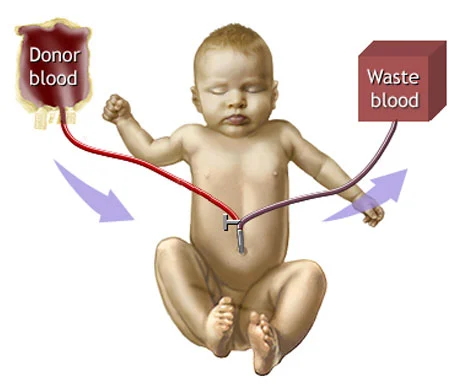


Exchange transfusion is a medical procedure used to replace a patient's blood with donor blood or blood products. This procedure is primarily employed in the treatment of certain serious medical conditions, such as severe anemia, hemolytic disease of the newborn, sickle cell disease, and certain cases of poisoning or metabolic disorders.
Treatment Procedure:
1. Preparation: Before the procedure, the patient's medical history is reviewed, and any relevant tests or evaluations are conducted to assess the need for exchange transfusion and to identify potential risks or complications. The patient's vital signs, including blood pressure, heart rate, and oxygen saturation, are monitored throughout the procedure.
2. Access: Access to the patient's bloodstream is established through the placement of intravenous (IV) catheters in the veins. Depending on the specific circumstances and patient's condition, one or more IV lines may be used for the exchange transfusion.
3. Blood Removal: A predetermined volume of the patient's blood is slowly withdrawn from their body through one IV line. This blood is typically removed in small increments to minimize the risk of complications, such as hypotension or clotting of the IV lines.
4. Blood Replacement: Simultaneously with the blood removal, an equal volume of donor blood or blood products (such as packed red blood cells, fresh frozen plasma, or albumin) is infused into the patient's bloodstream through another IV line. The goal is to replace the removed blood with healthy donor blood, thereby diluting and/or removing any harmful substances or components present in the patient's blood.
5. Monitoring: Throughout the exchange transfusion procedure, the patient's vital signs, including blood pressure, heart rate, and oxygen saturation, are closely monitored to detect any signs of complications, such as fluid overload, hypotension, or allergic reactions to the donor blood.
6. Post-procedure Care: After the exchange transfusion is completed, the patient is monitored closely for any immediate complications or adverse reactions. Depending on the specific circumstances and patient's condition, additional supportive care or monitoring may be necessary following the procedure.
Symptoms:
The symptoms associated with exchange transfusion can vary depending on the underlying medical condition being treated, the patient's overall health, and any potential complications that may arise during or after the procedure. Common symptoms may include:
- Fluctuations in blood pressure or heart rate during the procedure.
- Discomfort or pain at the IV insertion sites.
- Symptoms related to the underlying medical condition being treated, such as anemia, jaundice, or metabolic disturbances.
- Rarely, allergic reactions to donor blood products, such as fever, chills, rash, or shortness of breath.
It's important for patients undergoing exchange transfusion to receive comprehensive monitoring and supportive care from a healthcare team experienced in performing this procedure to minimize the risk of complications and optimize outcomes. Close observation and prompt intervention are essential to ensure the safety and well-being of patients undergoing exchange transfusion.